Related Research Articles

Brighton is a seaside resort and one of the two main areas of the city of Brighton and Hove in the county of East Sussex, England. It is located 47 miles (76 km) south of London. Archaeological evidence of settlement in the area dates back to the Bronze Age, Roman and Anglo-Saxon periods. The ancient settlement of "Brighthelmstone" was documented in the Domesday Book (1086). The town's importance grew in the Middle Ages as the Old Town developed, but it languished in the early modern period, affected by foreign attacks, storms, a suffering economy and a declining population. Brighton began to attract more visitors following improved road transport to London and becoming a boarding point for boats travelling to France. The town also developed in popularity as a health resort for sea bathing as a purported cure for illnesses.
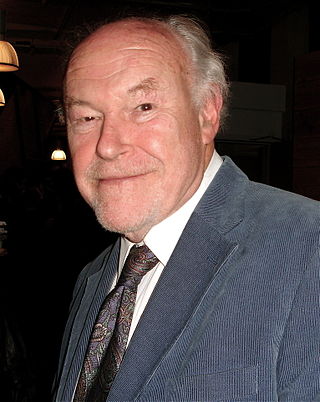
Timothy Lancaster West CBE FRSA was an English actor with a long and varied career across theatre, film, and television. He began acting in repertory theatres in the 1950s before making his London stage debut in 1959 moving on to three seasons with the Royal Shakespeare Company during the 1960s. During his life, West played King Lear and Macbeth (twice) along with other notable roles in The Master Builder and Uncle Vanya.

Worthing is a seaside town and borough in West Sussex, England, at the foot of the South Downs, 11 miles (18 km) west of Brighton, and 18 miles (29 km) east of Chichester. With a population of 113,094 and an area of 12.5 square miles (32.4 km2), the borough is the second largest component of the Brighton and Hove built-up area, the 15th most populous urban area in the United Kingdom. Northern parts of the borough, including the Worthing Downland Estate, form part of the South Downs National Park. In 2019, the Art Deco Worthing Pier was dubbed the best in Britain.

The South Street Seaport is a historic area in the New York City borough of Manhattan, centered where Fulton Street meets the East River, within the Financial District of Lower Manhattan. The Seaport is a designated historic district. It is part of Manhattan Community Board 1 in Lower Manhattan, and is next to the East River to the southeast and the Two Bridges neighborhood to the northeast.

The West Pier is a ruined pier in Brighton, England. It was designed by Eugenius Birch and opened in 1866. It was the first pier to be Grade I listed in England but has become increasingly derelict since its closure to the public in 1975. As of 2024 only a partial metal framework remains.

George Albert Smith was an English stage hypnotist, psychic, magic lantern lecturer, Fellow of the Royal Astronomical Society, inventor and a key member of the loose association of early film pioneers dubbed the Brighton School by French film historian Georges Sadoul. He is best known for his controversial work with Edmund Gurney at the Society for Psychical Research, his short films from 1897 to 1903, which pioneered film editing and close-ups, and his development of the first successful colour film process, Kinemacolor.
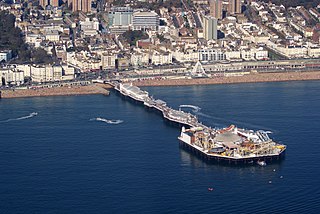
The Brighton Palace Pier, commonly known as Brighton Pier or the Palace Pier, is a Grade II* listed pleasure pier in Brighton, England, located in the city centre opposite the Old Steine. Established in 1899, it was the third pier to be constructed in Brighton after the Royal Suspension Chain Pier and the West Pier, but is now the only one still in operation. It is managed and operated by the Eclectic Bar Group.
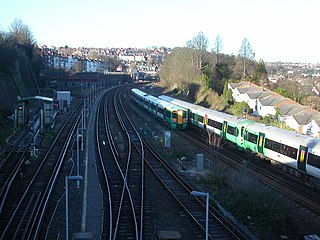
Public transport in Brighton and Hove, a city on the south coast of England, dates back to 1840. Brighton and Hove has a major railway station, an extensive bus service, many taxis, coach services, and it has previously had trolley buses, ferries, trams, auto rickshaws and hydrofoils.

James A. Williamson was a Scottish photographer and a key member of the loose association of early film pioneers dubbed the Brighton School by French film historian Georges Sadoul. He is best known for The Big Swallow (1901), a trick film with innovative use of extreme close-up, as well as Fire! and Stop Thief!, dramas with continuity established across multiple shots.
The Clown Barber is an 1898 British short black-and-white silent film directed and produced by the Scottish film pioneer James Williamson.
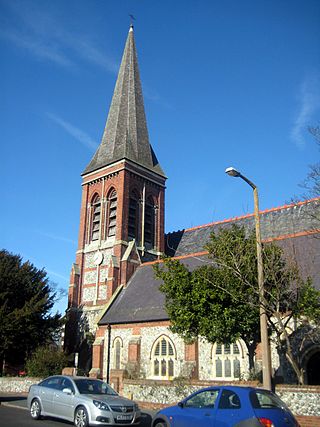
West Worthing is a neighbourhood of Worthing in West Sussex, England that was developed within Heene and later expanded beyond Heene's boundaries. Intended as an exclusive resort, the township of West Worthing was developed from around 1864 and merged with the formerly separate township of Worthing in 1890, when Worthing gained borough status.

Eastbourne is a town and seaside resort in East Sussex, on the south coast of England, 19 miles (31 km) east of Brighton and 54 miles (87 km) south of London. It is also a local government district with borough status. Eastbourne is immediately east of Beachy Head, the highest chalk sea cliff in Great Britain and part of the larger Eastbourne Downland Estate.
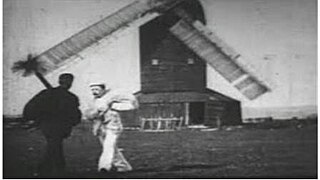
The Miller and the Sweep is a 1898 British short black-and-white silent comedy film, directed by George Albert Smith, featuring a miller carrying a bag of flour fighting with a chimney sweep carrying a bag of soot in front of a windmill, before a crowd comes and chases them away. The film, according to Michael Brooke of BFI Screenonline, "was one of the first films made by G.A. Smith, shortly after he first acquired a camera," and is also, "one of the earliest films to show a clear awareness of its visual impact when projected."

There are 24 Grade I listed buildings in the city of Brighton and Hove, England. The city, on the English Channel coast approximately 52 miles (84 km) south of London, was formed as a unitary authority in 1997 by the merger of the neighbouring towns of Brighton and Hove. Queen Elizabeth II granted city status in 2000.

The Brighton Wheel, also known during its planning and construction phase as the Brighton O and the Wheel of Excellence, was a transportable Ferris wheel installation which operated from October 2011 until May 2016 on the seafront in Brighton, part of the English city of Brighton and Hove. Situated below the East Cliff near Brighton Pier and built with private funding, its promoters anticipated that several hundred thousand visitors per year would experience the 12-minute ride. The wheel's location in a conservation area with many residential buildings proved controversial.
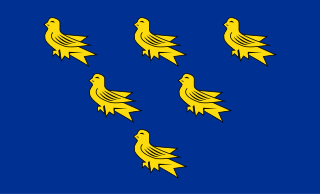
The culture of Sussex refers to the pattern of human activity and symbolism associated with Sussex and its people. It is informed by Sussex's history as an Anglo-Saxon kingdom, English county, diocese of the church and present-day cultural region.
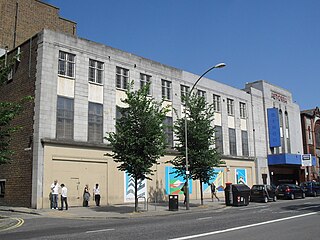
The Astoria Theatre was a former cinema in Brighton, part of the English coastal city of Brighton and Hove. Built in 1933 in the Art Deco style for a local entertainment magnate who opened one of Brighton's first cinemas many years earlier, it was the first and most important expansion of the Astoria brand outside London. It initially struggled against the town's other "super-cinemas", but enjoyed a period of success in the 1950s and 1960s before rapid decline set in, culminating in its closure in 1977.

The Bear Road area is a largely residential area in the east of Brighton, part of the English city of Brighton and Hove. Centred on the steep west–east road of that name, it is characterised by terraced houses of the early 20th century, but Brighton's main cemeteries were established here in the 19th century and there is also some industry.
Brighton School was a loosely associated group of pioneering filmmakers active in the Brighton and Hove area of England from 1896 to 1910. It was mostly a series of shorts and early projects made in the Brighton area.
Battersea Park was a railway station on the London, Brighton and South Coast Railway (LB&SCR) located close to the River Thames immediately to the south of Victoria Railway Bridge on the east side of Battersea Park in Battersea, south-west London.
References
- ↑ Barnes, John (1976). The Beginnings of the Cinema in England: 1898, the Rise of the Photoplay. David & Charles. p. 224. ISBN 978-1-85219-012-5.
- ↑ Brooke, Michael. "Early Fashions on Brighton Pier (1898)". Screenonline . British Film Institute . Retrieved 22 November 2013.
- ↑ Sopocy, Martin (1998). James Williamson: Studies and Documents of a Pioneer of the Film Narrative . Fairleigh Dickinson University Press. p. 258. ISBN 978-0-8386-3716-6.
- ↑ "On the West Pier". Screen Archive South East. Retrieved 22 November 2013.